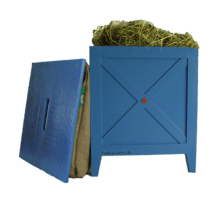Haybox



A hay box, straw box, fireless cooker, insulation cooker, wonder oven or retained-heat cooker is a cooker that utilizes the heat of the food being cooked to complete the cooking process. Food items to be cooked are heated to boiling point, and then insulated. Over a period of time, the food items cook by the heat captured in the insulated container. Generally, it takes three times the normal cooking time to cook food in a hay box.
History
Hay boxes are so called because hay or straw were the commonly used insulators. Pots of food would be brought to a boil and then placed in a box filled with hay or straw. Additional hay or straw would be added around and on top of the pot. The inventor Karl von Drais developed a novel form of haybox in the first part of the 19th century.
During World War II, hay boxes were used as a way of conserving rationed cooking fuel.[1]:26
Campers and hikers have used variations of hay boxes for years, heating their food in the morning and then storing the heated pot in a sleeping bag or backpack. In this way a hot meal is available for eating at the end of the day.
Commercial designs based on this principle differed only in details of construction, and the kind of insulating material used. Some types were provided with soapstone or iron plates which were heated during the preliminary cooking on the stove and then placed in the fireless cooker either over or under the cooking pot. In these types, a non-flammable insulating material was used. A successful home-made strategy was to take a box so large that the cooking pot when placed in it could be surrounded by a thick layer of non-conducting material, such as hay, excelsior or crumpled paper. A cushion was placed over the pot and a tight-fitting lid was placed over all.[2]
Advantages and disadvantages
Haybox cooking can save vast amounts of fuel, but there is a risk of bacterial growth if the food items are allowed to remain in the danger zone (41−140 °F or 5−60 °C) for one or more hours. In order to reduce the risk, food cooked in hay boxes can be reheated to boiling before eating, or a food thermometer can be used.
See also
- AGA cooker
- Slow cooker
- Thermal cooking
- Vacuum flask cooking
- Carry over cooking
- Chambers stove
- Wonderbag
Further reading
- Davis and Wood, Illustrated Lecture on the Home-made Fireless Cooker (United States Department of Agriculture, Syllabus 15, Washington 1914)
- Huntington, E. H., Fireless Cooker (University of Wisconsin Bulletin 217, Madison 1908)
- Lovewell, Whittemore and Lyon, The Fireless Cooker (Topeka 1908)
- Mitchell, M. J., The Fireless Cook Book (New York 1909)
- Still, Dean and Ness, Jim, "Capturing Heat:Five Earth-Friendly Cooking Technologies and How to Build Them (36 pages), Aprochevo Research Center publication, 2nd Edition—Newly revised and updated.
References
- ↑ Le Page, Martin. A Boy Messenger's War: Memories of Guernsey and Herm 1938-45. Arden Publications (1995). ISBN 978-0-9525438-0-0.
- ↑
 Rines, George Edwin, ed. (1920). "Fireless cooker". Encyclopedia Americana.
Rines, George Edwin, ed. (1920). "Fireless cooker". Encyclopedia Americana.